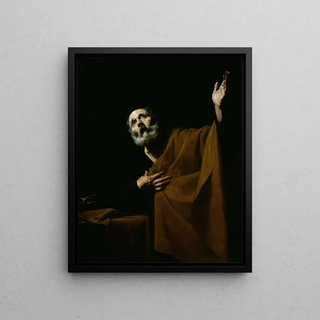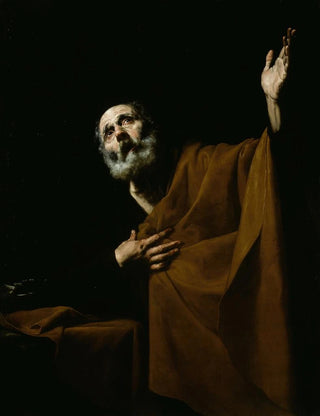Art print | Saint Pierre pénitent - Jusepe de Ribera


View from behind

Frame (optional)
Saint Peter Penitent - Jusepe de Ribera – Engaging Introduction
Within the captivating universe of baroque art, the art print "Saint Peter Penitent" by Jusepe de Ribera stands out for its emotional depth and powerful storytelling. This painting, created in the 17th century, depicts a pivotal moment in the life of the apostle Peter, highlighting his remorse after denying Christ. The scene, imbued with dramatic intensity, transports the viewer into an inner dialogue between faith and doubt, between light and shadow. Contemplating this work, one cannot help but feel a connection to the spiritual struggles that inhabit the character, offering a contemplative experience of rare intensity.
Style and uniqueness of the art print
Ribera's pictorial technique, characterized by striking chiaroscuro, gives "Saint Peter Penitent" an atmosphere that is both dark and luminous. The play of light accentuates the saint's facial features, revealing a mixture of anxiety and serenity. The texture of the drapery, rendered with exceptional meticulousness, draws the eye and highlights the artist's mastery in depicting materials. Every brushstroke seems loaded with meaning, every shadow bearing witness to the internal struggles of the protagonist. The composition, skillfully orchestrated, guides the viewer's gaze toward Peter's face, a true mirror of his tormented soul. This art print does not merely depict a religious scene; it invites introspection, reflection on the human condition, and the quest for redemption.
The artist and his influence
Jusepe de Ribera, an emblematic figure of Spanish baroque, knew how to establish himself through his unique style and his ability to capture the very essence of his subjects. Born in Spain but having spent much of his life in Naples, Ribera was influenced by the masters of Caravaggio, integrating their realistic and dramatic approach into his own creations. His work is characterized by a profound exploration of human emotions, often represented through biblical or mythological figures. Ribera transcended his era, leaving a legacy that has inspired many artists, both in Spain and abroad. His impact on the development of baroque, with particular attention

Matte finish

View from behind

Frame (optional)
Saint Peter Penitent - Jusepe de Ribera – Engaging Introduction
Within the captivating universe of baroque art, the art print "Saint Peter Penitent" by Jusepe de Ribera stands out for its emotional depth and powerful storytelling. This painting, created in the 17th century, depicts a pivotal moment in the life of the apostle Peter, highlighting his remorse after denying Christ. The scene, imbued with dramatic intensity, transports the viewer into an inner dialogue between faith and doubt, between light and shadow. Contemplating this work, one cannot help but feel a connection to the spiritual struggles that inhabit the character, offering a contemplative experience of rare intensity.
Style and uniqueness of the art print
Ribera's pictorial technique, characterized by striking chiaroscuro, gives "Saint Peter Penitent" an atmosphere that is both dark and luminous. The play of light accentuates the saint's facial features, revealing a mixture of anxiety and serenity. The texture of the drapery, rendered with exceptional meticulousness, draws the eye and highlights the artist's mastery in depicting materials. Every brushstroke seems loaded with meaning, every shadow bearing witness to the internal struggles of the protagonist. The composition, skillfully orchestrated, guides the viewer's gaze toward Peter's face, a true mirror of his tormented soul. This art print does not merely depict a religious scene; it invites introspection, reflection on the human condition, and the quest for redemption.
The artist and his influence
Jusepe de Ribera, an emblematic figure of Spanish baroque, knew how to establish himself through his unique style and his ability to capture the very essence of his subjects. Born in Spain but having spent much of his life in Naples, Ribera was influenced by the masters of Caravaggio, integrating their realistic and dramatic approach into his own creations. His work is characterized by a profound exploration of human emotions, often represented through biblical or mythological figures. Ribera transcended his era, leaving a legacy that has inspired many artists, both in Spain and abroad. His impact on the development of baroque, with particular attention






